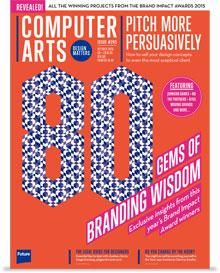Why hourly pricing is tantamount to punching yourself in the face
Don't be punished for being good at what you do, says Sabrina Smelko.
Award-winning graphic designer and illustrator Sabrina Smelko includes Cadbury and The New York Times among her clients. Here she talks hourly pricing and knowing your value.

People turn to charging hourly because it seems easier than conjuring up some random flat fee, but you're only punishing yourself by doing this.
Pricing hourly can be a slippery slope that leads to being underpaid, bitter and anxious. It's counter-intuitive to growing as a professional. And that's no fun.
Let's say you're just starting out as a new designer and you're charging $50 hourly. Project X takes you 10 hours, so you get $500 for the job.
Years later, you're more experienced and your skill level is far better – you work faster, you're more efficient and a more well-rounded human being – and that same job could now be done in half the time, meaning you'd get $250 for it.

That's right – you, a more experienced, advanced designer, are making less for all of your experience and knowledge. So, for the sake of argument, let's say over those few years you were smart enough to increase your rate from $50 to $100 (a significant jump which I guarantee clients will notice and do the math on).
You'd still only be making $500, which, need I remind you, is the same amount as you did when you first started.
And what's worse? Your clients will likely turn their nose up at your price increase, pinch the pennies and (in some cases) call you out.
Alternatively you might get told, "Listen: you're good at this and it's easy for you, so can you have a new pricing model where your fee changes depending on how easy a project is for you to do?"
And, feeling defeated, you may cave – but fight that wimpy urge! You should respond with, "My time is worth my time," but this response is often misunderstood (I speak from experience), leaving both the client and you a bit limp.
There is one proven way to make more money with hourly pricing: by lying and finding ways to spend more time on a project while your client is trying to do the opposite. Doesn't that sound like a great idea? No, it's extremely awkward is what it really is.
Never be paid less for being good
Lesson learned: you should never be paid less simply because you're good at something. In fact, you should be compensated fairly for that expertise. How easy something is for you to do should never dictate pricing. It's unfair to be punished for being good at what you do. That's the problem with hourly pricing: it's completely counter-intuitive.
So what should you do? How should you price? There are so many factors that come into play, but in general pricing a flat fee based on value is typically more fair for everyone involved.
Value-based pricing means you price based on a few factors: your time spent; your skill level and experience; the actual scope of the work (what's really needed), and details such as usage, due date, number of anticipated revisions, size of the client and so on.
So if you plan on getting better at what you do, please do yourself a favour and consider charging based on value rather than by the hour.

The full version of this feature first appeared inside Computer Arts issue 245, a branding design special packed with expert tips for creating outstanding branding.
Liked this? Read these...
- What to do when a client rejects your designs
- Art students make budget parody of John Lewis Christmas advert
- The designer's guide to working from home

Thank you for reading 5 articles this month* Join now for unlimited access
Enjoy your first month for just £1 / $1 / €1
*Read 5 free articles per month without a subscription

Join now for unlimited access
Try first month for just £1 / $1 / €1
Get the Creative Bloq Newsletter
Daily design news, reviews, how-tos and more, as picked by the editors.
The Creative Bloq team is made up of a group of design fans, and has changed and evolved since Creative Bloq began back in 2012. The current website team consists of eight full-time members of staff: Editor Georgia Coggan, Deputy Editor Rosie Hilder, Ecommerce Editor Beren Neale, Senior News Editor Daniel Piper, Editor, Digital Art and 3D Ian Dean, Tech Reviews Editor Erlingur Einarsson, Ecommerce Writer Beth Nicholls and Staff Writer Natalie Fear, as well as a roster of freelancers from around the world. The ImagineFX magazine team also pitch in, ensuring that content from leading digital art publication ImagineFX is represented on Creative Bloq.
